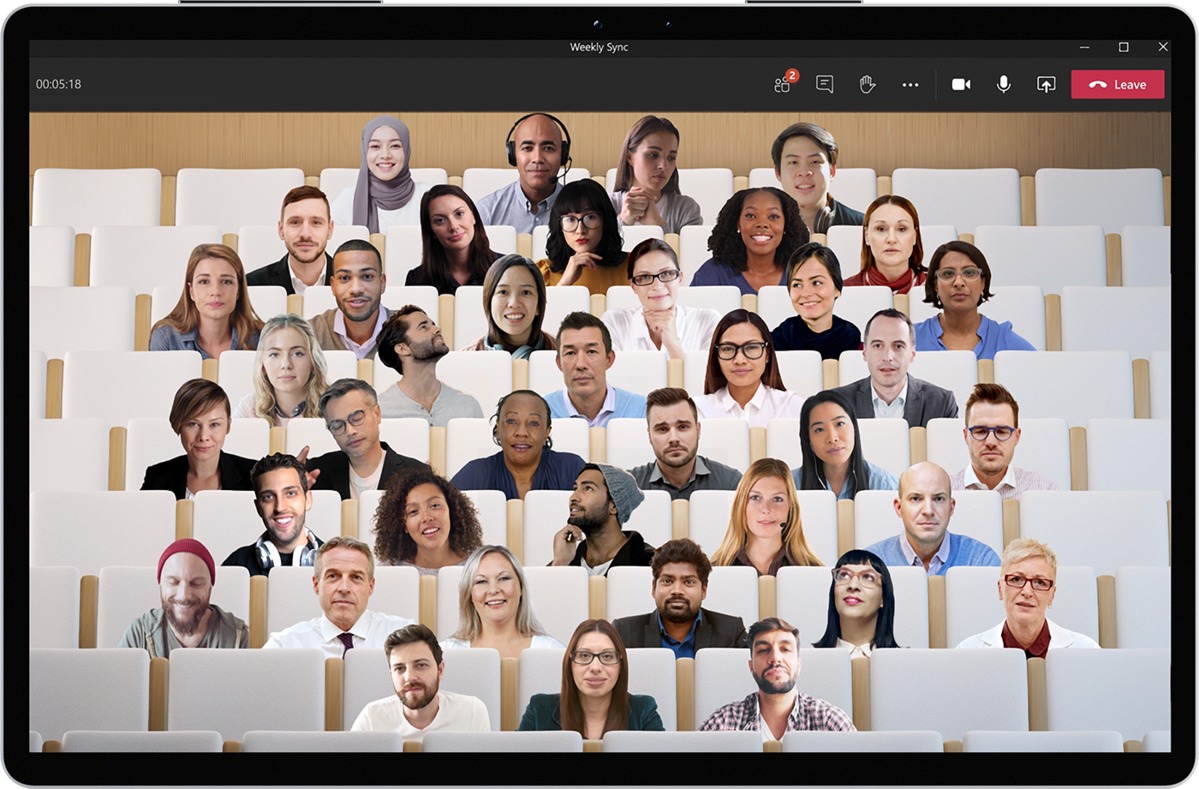In an effort to make video calls more “inclusive, engaging and reflective,” Microsoft is rolling out a host of new Teams features – including a viewing mode that puts everyone in the same room.
Microsoft Teams on Wednesday unveiled a slew of new updates to its video conferencing software, including a “Together mode” that puts participants in a virtual meeting hall. That and other changes will be rolled out to users next month.
The most significant update is the new Together mode, which, as the name suggests, aims to make video conferences more informal and bring participants together. Instead of 49 individual participant rectangles appearing in gallery mode, switching to Together mode removes the barriers between participants and uses “AI segmentation technology” to place the head and shoulders of participants side by side in a virtual auditorium.
Microsoft is currently working on other views that will available in this mode, including a virtual coffee shop.
Jaron Lanier, the CTO Prime Unifying Scientist at Microsoft, said the new viewing mode is a direct consequence of the pandemic and the significant increase in the number of video calls people make.
“This is very much a specific design in response to the pandemic. The design was initiated during the pandemic, developed during the pandemic and is released during the pandemic,” Lanier said.
With many employees now in the midst of their fourth month working from home because of the COVID-19 outbreak, daily video calls with colleagues have become the new normal as teams try to continue working collaboratively across different environments. During pandemic, Teams has seen its daily active user count jump to 44 million, then surge past 75 million. In response, the platform has evolved over the last several months to improve the experience for both existing and new users.
Though at first Together mode might seem a like a gimmick, the underlying technology is fundamental to improving the video conferencing experience.
On most video calls, eye contact – or the lack of – is an ongoing problem, with people often appearing to look in the wrong direction. Together mode mimics the geometry of reflection, meaning that every participant is looking at the whole group through a big virtual mirror.
“Once direct eye contact errors become hard to detect, people intuitively position themselves to look as if they are reacting to one another appropriately,” Lanier explains. Microsoft said its research has shown that as a result people tend to feel happier and more engaged in meetings.
Additionally, everyone in Together mode is in a fixed position. If one person happens to appear in the fourth seat of the bottom row on their own screen, that person would appear in the fourth seat of the bottom row on everyone else’s screen.
Angela Ashenden, principle analyst for workplace transformation at CCS Insight ,said the combination of both features helps to make the video meetings feel more natural. She notes that if a meeting leader tells everyone to click a button on the right of the screen, you see everyone’s gaze looking in the same direction.
“It’s interesting that Microsoft’s research shows this helps people cope better with video meetings, and helps them better retain information that’s shared in this setting,” Ashenden said. “Given the volume of video meetings many of us are attending as a result of COVID-19, features that make the experience more comfortable and make the meetings themselves more enjoyable and productive are extremely important.”
What else is new?
While Together mode is the main new Microsoft Teams feature, it’s not the only update rolling out in August.
Dynamic view will make it easier for participants to share content on-screen alongside the view of your participants – a direct contrast to Together mode which currently does not offer users the ability share content or present. Dynamic view also includes virtual breakout rooms, where participants can be split into smaller groups for more focused discussions or brainstorming sessions.
In a further effort to make meetings more inclusive, Teams is also rolling out live reactions and emojis, providing participants with the ability to react instantly to each other in a non-verbal way. In-meeting chats sent during a Teams session will appear as on-screen chat bubbles, eliminating the need for users to open a separate chat window and distracting them from the video call. Teams is also introducing suggested replies, similar to those in Outlook and Gmail, allowing users to give quick feedback.
Those who use Microsoft Teams via the mobile app willl soon be able to have the company’s voice assistant, Cortana, make calls, join meetings, send chat messages and share files. Microsoft is also adding live transcripts to Teams later this year along with the ability to translate live captions into subtitles so anyone can follow a meeting conducted in another language.
Finally, Teams users will be given access to video filters, allowing them to subtly adjust lighting levels and soften the focus of the camera to customize their appearance.
In the blog post touting the updates, Jared Spataro, corporate vice president for Microsoft 365, said the new features reflect how Teams customers have already been using the tools and an acknowledgment that “the world has moved from an era of ‘remote everything’ into a more hybrid model of work, learning, and life.”
Ashenden echoed that point, arguing that the updates help position Microsoft as an innovator in videoconferencing, and go beyond just adding features that are popular in competitors’ products.
“The breadth of new capabilities that are being added to Teams at the moment shows the level of investment in the product, and its growing importance in the company’s overall strategy,” she said. “As Teams’ adoption continues to grow, it’s important for Microsoft to enhance and improve the experience for users, to maximize its value in helping people be productive and collaborate effectively.”
This article originally appeared on ComputerWorld.

